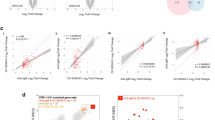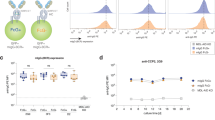Abstract
THE Fc receptor on B lymphocytes, FcγRIIB (β1 isoform), helps to modulate B-cell activation triggered by the surface immunoglobulin complex1,2. Crosslinking of membrane immunoglobulin by antigen or anti-Ig F(ab′)2 antibody induces a transient increase in cytosolic free Ca2+, a rise in inositol-3-phosphate, activation of protein kinase C, and enhanced protein tyrosine phosphorylation3–5. Crosslinking FcγRIIB with the surface immunoglobulin complex confers a dominant signal that prevents or aborts lymphocyte activation triggered through the ARH-1 motifs of the signal transduction subunits Ig-α and Ig-β. Here we show that FcγRIIB modulates membrane immunoglobulin-induced Ca2+ mobilization by inhibiting Ca2+ influx, without changing the pattern of tyrosine phosphorylation. A 13-amino-acid motif in the cytoplasmic domain of FcγRIIB is both necessary and sufficient for this effect. Tyrosine at residue 309 in this motif is phosphorylated upon co-crosslinking with surface immunoglobulin; mutation of this residue aborts the inhibitory effect of FcγRIIB. This inhibition is directly coupled to signalling mediated through Ig-α and Ig-β as evidenced by chimaeric IgM/α and IgM/β molecules. The 13-residue motif in FcyRIIB controls lymphocyte activation by inhibiting a Ca2+ sig-nalling pathway triggered through ARH-1 motifs as a result of recruitment of novel SH2-containing proteins that interact with this FcγRIIB cytoplasmic motif.
This is a preview of subscription content, access via your institution
Access options
Subscribe to this journal
Receive 51 print issues and online access
$199.00 per year
only $3.90 per issue
Buy this article
- Purchase on Springer Link
- Instant access to full article PDF
Prices may be subject to local taxes which are calculated during checkout
Similar content being viewed by others
References
Ravetch, J. V. & Kinet, J.-P. A. Rev. Immun. 9, 457–492 (1991).
Mellman, I. Curr. Opin. Immun. 1, 16–25 (1988).
Reth, M. A. Rev. Immun. 10, 97–121 (1992).
Desiderio, S. V. Curr. Opin. Immun. 4, 252–256 (1992).
Cambier, J. C. & Ransom, J. T. A. Rev. Immun. 5, 175–199 (1987).
Wilson, H. A. et al. J. Immun. 238, 1712–1718 (1987).
Ransom, J. T. et al. J. Immun. 140, 3150–3155 (1988).
Carter, R. H., Park, D. J., Rhee, S. G. & Fearon, D. T. Proc. natn. Acad. Sci. U.S.A. 88, 2745–2749 (1991).
Ransom, J. T., Harris, L. K. & Cambier, J. C. J. Immun. 137, 708–714 (1986).
Jones, B., Tite, J. P. & Janeway, C. A. J. Immun. 136, 348–356 (1986).
Gold, M. R., Matsuuchi, L., Kelly, R. B. & DeFranco, A. L. Proc. natn. Acad. Sci. U.S.A. 88, 3436–3440 (1991).
Hunziker, W., Koch, T., Whitney, J. A. & Mellman, I. Nature 345, 628–632 (1990).
Amigorena, S. et al. Science 256, 1808–1812 (1992).
Reth, M. Nature 338, 383–384 (1989).
Letourneur, F. & Klausner, R. D. Science 255, 79–82 (1992).
Romeo, C., Amiot, M. & Seed, B. Cell 68, 889–897 (1992).
Irving, B. A., Chan, A. C. & Weiss, A. J. exp. Med. 177, 1093–1103 (1993).
Kolanus, W., Romeo, C. & Seed, B. EMBO. J. 11, 4861–4868 (1992).
Sanchez, M. et al. J. exp. Med. 178, 1049–1055 (1993).
Clark, M. R. et al. Science 258, 123–126 (1992).
Kameyama, M., Hoffmann, F. & Trautwein, W. Pflugers Arch. 405, 285–293 (1985).
Songyang, Z. et al. Cell 72, 767–778 (1993).
Brooks, D. G., Qiu, W. Q., Luster, A. D. & Ravetch, J. V. J. exp. Med. 170, 1369–1386 (1989).
Weissman, A. M. et al. Proc. natn. Acad. Sci. U.S.A. 85, 9709–9713 (1988).
Ravetch, J. V. et al. Science 234, 718–725 (1986).
Lai, M.-Z. et al. J. Immun. 139, 3973–3980 (1987).
Author information
Authors and Affiliations
Rights and permissions
About this article
Cite this article
Muta, T., Kurosaki, T., Misulovin, Z. et al. A 13-amino-acid motif in the cytoplasmic domain of FcγRIIB modulates B-cell receptor signalling. Nature 368, 70–73 (1994). https://doi.org/10.1038/368070a0
Received:
Accepted:
Issue Date:
DOI: https://doi.org/10.1038/368070a0
This article is cited by
-
Perspective view of allogeneic IgG tumor immunotherapy
Cancer Cell International (2024)
-
BTK inhibitors in the treatment of hematological malignancies and inflammatory diseases: mechanisms and clinical studies
Journal of Hematology & Oncology (2022)
-
The role of IgG Fc receptors in antibody-dependent enhancement
Nature Reviews Immunology (2020)
-
Engagement of CD22 on B cells with the monoclonal antibody epratuzumab stimulates the phosphorylation of upstream inhibitory signals of the B cell receptor
Journal of Cell Communication and Signaling (2016)
-
Regulation of Monoclonal Antibody Immunotherapy by FcγRIIB
Journal of Clinical Immunology (2016)
Comments
By submitting a comment you agree to abide by our Terms and Community Guidelines. If you find something abusive or that does not comply with our terms or guidelines please flag it as inappropriate.



